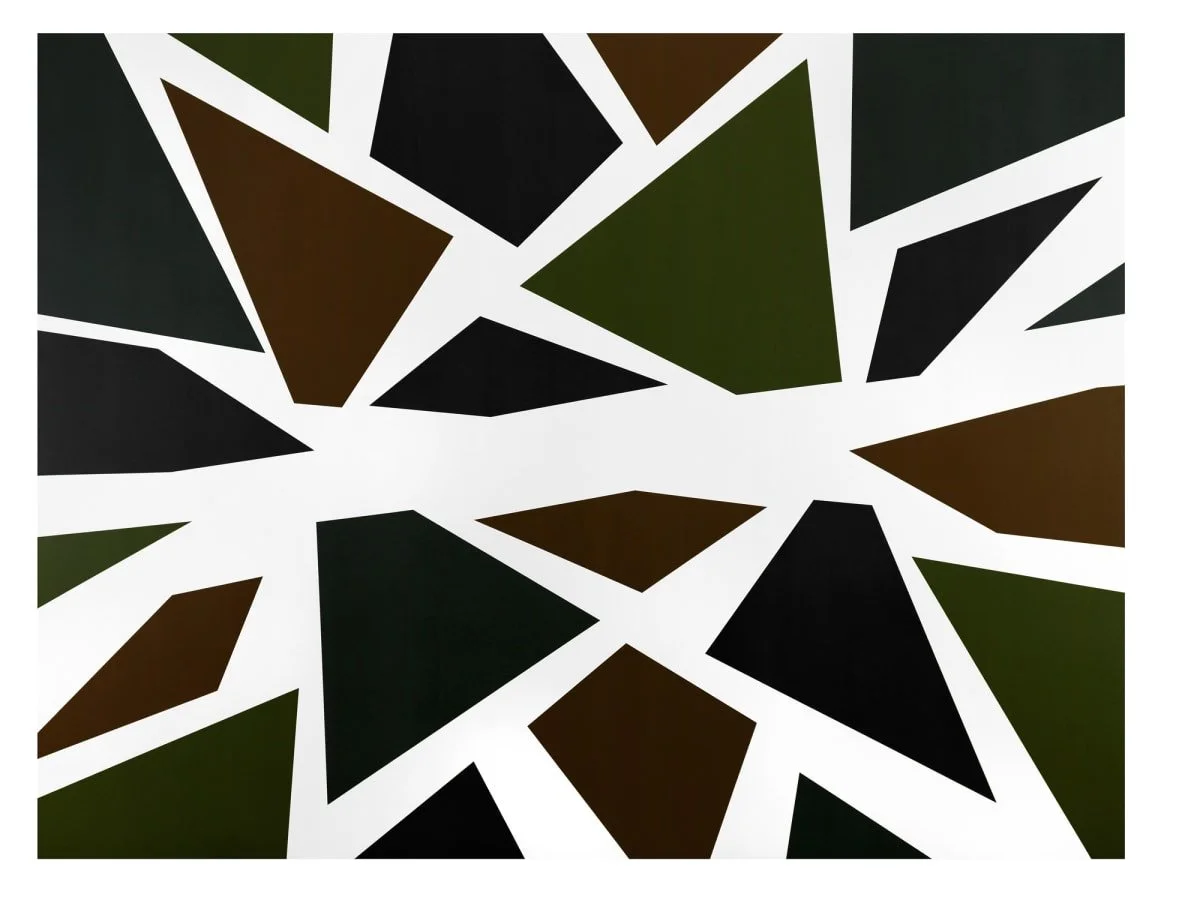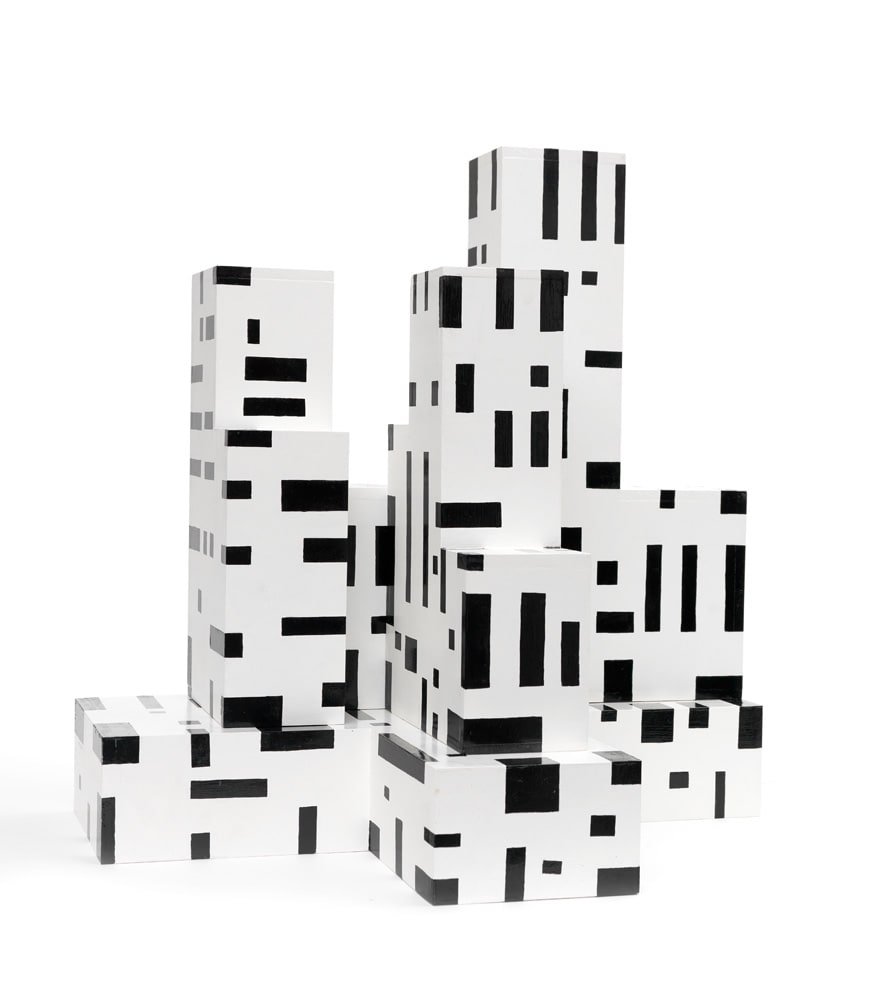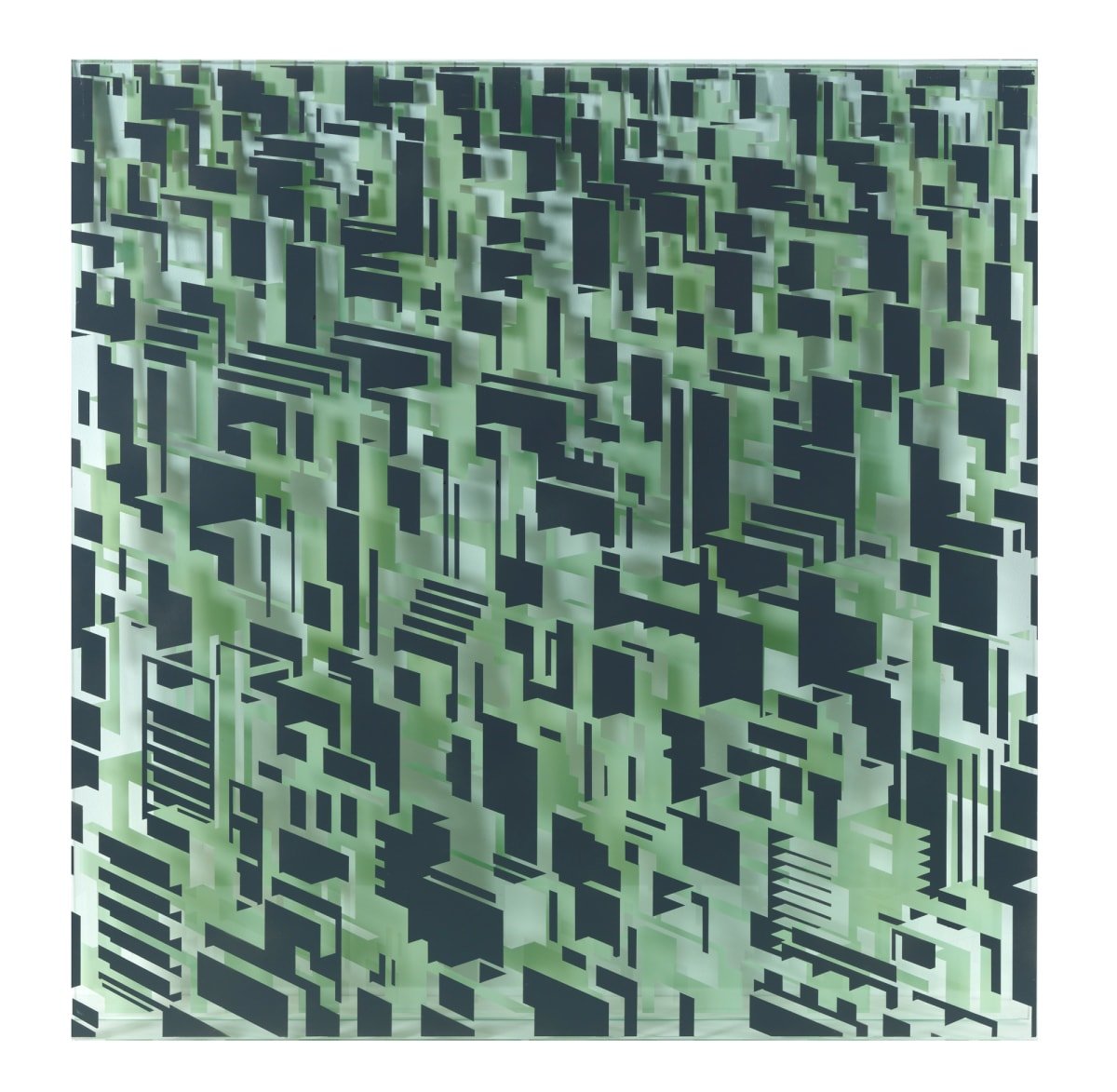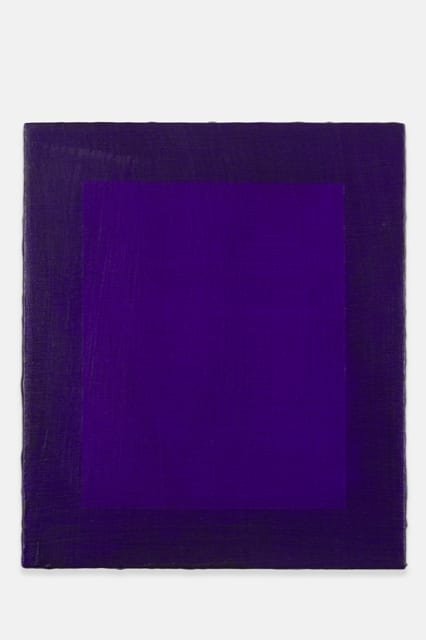ARTitecture presents works by artists represented in the JAHM collection, each expressing an idea related to architecture and the built world. However, unlike architects, these artists are unencumbered by the demands of functionality, such as the client brief, regulations, budgets, constructability, context, sustainability and timeframes that are imposed on architects in producing a work of architecture.
With this unencumbered freedom what are the artists saying? Are they reflecting and critiquing how architecture is created, on how we engage with it when realised? What impact does it have on our lives and what impact does it have on our future?
Using art from the JAHM collection, these big ideas will be explored through interactive guided tours.
Each tour is followed by refreshments in the private apartment where recent acquisitions to the JAHM collection are on display. JAHM tours of ARTitecture are available to book now.
EXHIBITION CATALOGUE
CURATORIAL ESSAY
Written by Charles Justin AM, Justin Art House Museum
My introduction to architecture was at the School of Architecture at the University of Melbourne in 1964. Five years studying, one year undertaking work experience in an architect’s office and then travelling, and one year repeating a couple of subjects part time. It was during this year that I met Alan Synman. In my following final year, I got married and scraped through the course. Following graduation, I joined Alan’s practice, became his business partner that eventually became SJB (Synman Justin Bialek) in 1976.
I remember as a young, recently graduated, but unregistered architect, when visiting a building site, the tradesmen (colloquially referred to as ‘tradies’) would refer to me as the ‘Artitect’. When I look back, I somewhat arrogantly interpreted their mispronunciation as a result of their lack of sophistication or education.
When I did become registered some years later, I could finally call myself an architect. But it took some more years and experience to appreciate what it really meant to be an architect and what was involved in putting a building together. The main and complex challenge was that of coordinating hundreds if not thousands of consultants, contractors, tradesman, craftsman, artisans, workers, technicians and other professionals, each with their own speciality and skill, and work together to produce a completed building. I also realised how the quality of the final outcome was ultimately dependent on the weakest link in that long chain of decisions and deadlines.
During that process, each of the specialists responsible for the delivery of the building saw the end result through the perspective of their own speciality and experience. However, it is only the architect who has the holistic vision of the totality of the envisioned building and has the responsibility to synthesise these diverse threads, in the most cohesive, efficient, elegant and hopefully beautiful way.
With age and some acquired wisdom, I realized that perhaps the tradie used the term ‘Artitect’, because he (it was usually he in those days) understood the artistry required to create such a work of architecture including integrating that tradies contribution in the complete whole.
In the third year of my architecture course, we were required to undertake a Fine Arts subject conducted by the Arts Faculty. One of the references was A History of Modern Art: Painting-Sculpture- Architecture by H. H. Arnason, published by Thames and Hudson. Having studied physics, material science, drawing, perspective, design, architectural history, professional practice and surveying, I became aware of the notion that architecture was also art. That is: the forces that drove the development of painting and sculpture were also the forces that drove the development of architecture. Each of these disciplines were reflections of, and contributors to, the evolving culture of the people and places where these disciples were created.
The date noted in Arnason’s A History of Modern Art as the start of the modern art era, was 1863, the year of the Salon des Refusés in Paris. What is clear from this history, which spans from the 1860’s to the 1960’s is that artists and architects operate differently. Yet each, through their creative endeavours have the potential to create works that can be considered part of the art canon. This separation of creatives into specialities, such as artists, architects, designers, graphic designers, industrial designers was a feature of the modern era, resulting from the growing complexity in these fields of endeavour. This specialisation had similarly occurred in other professions such as medicine, law, finance.
However, this distinction between artists and architects was not the case in the past. In ancient times artists and architects were generally unknown and both were considered artisans. They worked together to deliver the tombs in Egypt, the temples, palaces and public buildings in Greek and Roman times and the churches and cathedrals in the Middle Ages. The architecture, painting and sculpture were integrated into a unified whole.
In the Renaissance, painters, sculptors and architects were identified and celebrated as in Giorgio Vasari’s book The Lives of the Most Excellent Painters, Sculptors and Architects written in the sixteenth century. Many were like Vasari himself: artist and architect. Great architects of the Renaissance such as Leonardo da Vinci, Michelangelo, Raphael and Bramante were also outstanding artists, in addition to scientists and engineers, which led to the concept of the Renaissance Man.
In these periods, artists operated similarly to architects today. They were guns-for-hire, commissioned by clients to produce works to fulfill a brief that represented their needs or purpose. Patrons were generally wealthy: from the ruling class, the aristocracy, the clergy, merchants and people of power. Artists had large studios with assistants, apprentices and staff organised as a commercial enterprise. In these periods architects did exist but weren’t trained as such and were not recognised as a profession. They developed from other disciplines such as engineers, builders, master-masons and even artists. They were in many cases self-taught or apprenticed to acquire the necessary skills.
The Enlightenment Period, from the 17th to 19th century, incorporating the Scientific Revolution, the French Revolution and the Industrial Revolution brought about dramatic change. Individual rights, emancipation of the masses, introduction of universal education, the beginnings of democracy, technological advancement such as electricity, transport, telephone and photography effected every sphere of life including art and architecture.
Art practice morphed from fulfilling a patron’s commissions, to one of individualism and self-expression. Photography fundamentally impacted the artist’s role in image making. Commercial art galleries became established in the mid 19th century. It was also in the mid 19th century that architecture was recognized as a distinct profession with the establishments of schools of architecture and professional architectural associations.
In 1964 when I started my architecture degree, the profession of architecture was firmly established, recognized and respected. It was also the year that Architecture without Architects by Bernard Rudofsky was published. This radical little book presented diverse examples of vernacular or folk architecture, demonstrating its artistic, functional and cultural richness. The book accompanied an exhibition that Rudofsky curated at MoMA in New York. In many ways it presented an alternative view of architecture to that of the famous exhibition on architectural modernism curated by Phillip Johnson, also at MoMA in 1938, Modern Architecture: International Exhibition. Rudofsky’s thesis put me on notice, because although these buildings were not created by architects, they represented the essence of architecture. These buildings responded to how people lived, their climate, their environment, their technology, the materials at hand and they contributed to their culture that defined their society.
Architecture Without Architects was very confronting as I was about to embark on my architectural career. I didn’t realize at the time but living in the 60’s everything was being challenged including politics, the law, gender, religion, race, sex, individual rights. Even art was being challenged in changing directions and philosophies by new art movements such as arte povera, conceptual art, abstraction, minimalism, pop art, performance art, installation art, land art.
In 2018 I was challenged even further; this time about art. I was invited to participate in a panel at the annual seminar conducted by the NGV Women’s Association. The panel had a diverse group of people from the art world exploring their different perspectives on the changing ways we see art. One of the panellists, artist Adrian Doyle, was the director of Blender Studios and Melbourne Street art tours. He was also an artist undertaking commissioned wall murals, as well as self-expressive paintings. In response to a question, he commented that his ultimate satisfaction was in doing useless art (painting) rather than the useful art (murals). It was the first time I had heard the distinction between useless and useful art, which I subsequently found was not uncommon terminology in the art world. I found the concept of art being useless very confronting, as I always considered that art played a profound role in our culture and lives.
I realized on further thought, that this definition positioned the role of self-expression in art in its purest form, totally unencumbered by any references or obligations. ‘Useless’ was not a reflection on arts purpose, but of its functional or utilitarian character. Human creativity is regarded as the key ingredient which distinguishes humans from other life forms. Our capacity to imagine an idea and translate it into some physical form is what has allowed us to create the world we live in today. Human creativity has developed from the beginning in two streams, the utilitarian or non-utilitarian. The utilitarian stream includes architecture, engineering, technology, design, craft and science and the non-utilitarian stream embraces visual art, music, literature, theatre, opera and storytelling. Why do we have this distinction between two streams of creativity? At JAHM we believe the former helps us shape how we live; the latter helps us understand why we live.
I regard the NGV as one of the world’s great art museums. In addition to its collection of painting, sculpture, drawing, prints, photography, video and media art, it also holds examples of furniture, crockery, silverware, tapestries and clothing. It even commissions works of temporary architecture. All this ‘stuff’ is in an art museum, so it must be art, where non-utilitarian and utilitarian art is now categorized as Fine Art and Applied Art. What defines these works as art that is fit to be in an art museum? At JAHM, our view is that artists are visual philosophers who in their work reflect and critique the world they live in, and possibly provide insights into how our world is changing or should change. This view I believe applies both to Fine Art and Applied Art, as well as to art and architecture. Utilitarian works, as in Applied Art and architecture, that transcend mere functionality to profoundly say something about the time and place where they were created, in our view can be regarded as art. Whether it is regarded highly enough to be included in a museum collection or in a history book is a decision made by experts, curators, critics, collectors and writers. Nonetheless it is still subjective, history is the ultimate judge.
Respected art critic and commentator Hal Foster argues in The Art- Architecture Complex that the fusion of art and architecture is a defining feature of contemporary society. Art is becoming more like architecture and architecture more like art. Examples would be buildings like Frank Gehry’s Guggenheim Museum in Bilboa which has all the qualities of a monumental sculpture and Richard Serra’s monumental sculptures which have the scale and experiential qualities of a work of architecture. There are recent examples of artists and architects working together to create sculptural buildings such as Webb Bridge where architects DCM collaborated with artist Robert Owen to create a pedestrian and cycle bridge over the Yarra at Docklands. Similarly, architects Herzog de Meuron collaborated with artist Ai Weiwei to create the Olympic National Stadium in Beijing. Each of these examples present a fusion of architecture and art. At JAHM we commissioned 3 artists to create 3 art projects that were integrated into the architecture to create immersive experiences. The commercial world is appointing architects and artists to work together to create immersive experiences to attract customers in areas such as retail, hospitality, entertainment, tourism and sport. One of the consequences is the impact that commercial interests have on our cultural interests. Perhaps we are coming full circle and seeing the end of the distinction between art and architecture and their fusion for the creation of immersive physical environments for the human experience.
This ARTitecture exhibition at JAHM, presents works by artists represented in our collection, each expressing an idea related to architecture and the built world. However, unlike architects, these artists are unencumbered by the demands of functionality, such as the client brief, regulations, budgets, constructability, context, sustainability and timeframes that are imposed on architects in producing a work of architecture. With this unfettered freedom what are the artists saying about architecture and the built world? Are they reflecting and critiquing how architecture is created; on how we engage with it when realized; the impact it has on our lives and the impact it may have on our future? That is what we at JAHM hope to explore in this exhibition.
STAY CONNECTED
Be sure to keep up with all JAHM updates and Australian exhibition highlights by connecting to our socials. And if you haven’t already, subscribe to our mailing list to receive newsletters with all details of upcoming programs and tours at JAHM.




























































